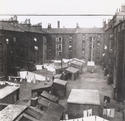 My Glasgow in the 1950s was a warm bustling sort of "Dirty Old Town" where everybody, it seemed, stayed up a "close". Tenements still dominated the urban landscape, whether in the working-class districts of Anderston to the north of the River Clyde, or Gorbals to the south. West-end Hyndland and east-end Dennistoun were among the more douce residential areas where quality building prevailed. Whatever the community's profile, there were shared features of tenement life. From the tram stop at the closemouth the tram rattled all the way into town along streets lined with shops at pavement level and three or four storeys of houses above. There were usually pubs and dairies at the street corners, with libraries, churches, schools, picture houses - you name it - in between.
My Glasgow in the 1950s was a warm bustling sort of "Dirty Old Town" where everybody, it seemed, stayed up a "close". Tenements still dominated the urban landscape, whether in the working-class districts of Anderston to the north of the River Clyde, or Gorbals to the south. West-end Hyndland and east-end Dennistoun were among the more douce residential areas where quality building prevailed. Whatever the community's profile, there were shared features of tenement life. From the tram stop at the closemouth the tram rattled all the way into town along streets lined with shops at pavement level and three or four storeys of houses above. There were usually pubs and dairies at the street corners, with libraries, churches, schools, picture houses - you name it - in between.
 The streets were granite-setted and noisy, but solid and convincing like the stone-built tenements that formed the "inhabited wall" that lined the street and separated it from the back court where "weans" could play in safety under a myriad of watching eyes and washing flapping in the breeze. Glasgow had over a million residents in 1951 and so the tenements generated people everywhere – neighbours on the stairs, pals and rivals jostling in the playground, queues for the "pictures", the "fitba" and dancing. The density was mitigated and ventilated by great green parks, laid out according to the 19th century tradition of French "Haussmannised" planning.
The streets were granite-setted and noisy, but solid and convincing like the stone-built tenements that formed the "inhabited wall" that lined the street and separated it from the back court where "weans" could play in safety under a myriad of watching eyes and washing flapping in the breeze. Glasgow had over a million residents in 1951 and so the tenements generated people everywhere – neighbours on the stairs, pals and rivals jostling in the playground, queues for the "pictures", the "fitba" and dancing. The density was mitigated and ventilated by great green parks, laid out according to the 19th century tradition of French "Haussmannised" planning.
 Yet while the tightly packed population encouraged a vigorous sense of community, tenements were also synonymous with Glasgow's slums. The revelation of the 1951 Census that thirty-seven per cent of city families shared a toilet with their neighbours meant that clearance of the more decrepit districts became a top political priority. Hutchesontown and Gorbals were much-publicised symbols of this transformation with tenements giving way to modern flats, maisonettes and high-rise. The demolition and rebuilding programme dispersed population and eased congestion, but the popularity of tenements began to revive. Community-based rehabilitation projects, beginning in Govan from 1972, demonstrated how successfully traditional sandstone tenements could be adapted for the housing needs of the late 20th century.
Yet while the tightly packed population encouraged a vigorous sense of community, tenements were also synonymous with Glasgow's slums. The revelation of the 1951 Census that thirty-seven per cent of city families shared a toilet with their neighbours meant that clearance of the more decrepit districts became a top political priority. Hutchesontown and Gorbals were much-publicised symbols of this transformation with tenements giving way to modern flats, maisonettes and high-rise. The demolition and rebuilding programme dispersed population and eased congestion, but the popularity of tenements began to revive. Community-based rehabilitation projects, beginning in Govan from 1972, demonstrated how successfully traditional sandstone tenements could be adapted for the housing needs of the late 20th century.